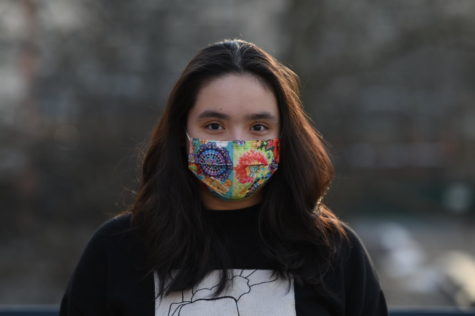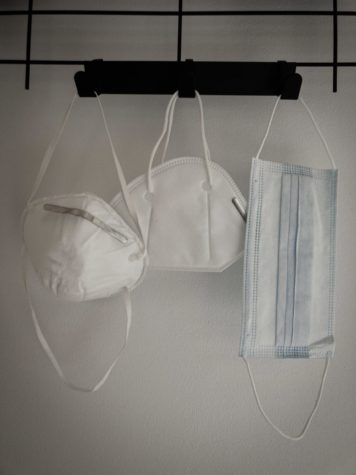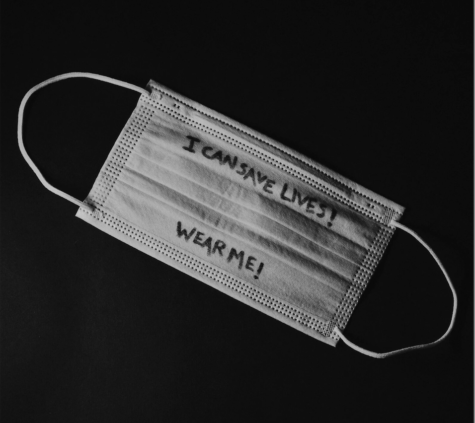Which is the Best Mask For Protection Against COVID-19?
With thousands of COVID-19 cases just beginning to decline across New York and mask mandates expiring, it is of utmost importance to remain protected against further strains.
As much as we would like for the world to return to “normal,” masking is a part of our larger reality.
If I tallied all of the masks that I’ve gone through during the past twenty-four months since the start of the Coronavirus pandemic in mid March 2020, I’d be into the hundreds. I’ve been back and forth between cloth, surgical, KN95, and N95 more times than I can count.
With the sight of a mask, many pandemic struggles come flooding to the forefront of one’s mind — the distancing, testing, isolation, and constant worry. Masks can emphasize someone’s caution, care for their community, style, and originality. To Iffath Liaquat ’24, masks show if a person “[is] creative and fashionable or [is] very safe.” Besines Santana ’24 said, “people do what they want to do, [but] as long as they are actually wearing [masks], then I have no problem.”
Masks have even influenced trends, as magazines such as Vogue and Rolling Stone published opinion pieces on “the most stylish masks.” Commercial sites like Amazon and Redbubble, designer brands like Louis Vuitton, and even Bronx Science itself, have made merchandise in accordance with the latest trends (although these – usually cloth – masks are often less effective).

The importance of masking dates back centuries. One can easily visualize the classic beak-like masks employed during the Black Plague. Although the intention of those masks, later proven incorrect, was to block the smell of the dead, the thick leather material and antiseptic herbs, which had been placed to overpower the scent, saved the lives of plague doctors.
In 1897, Polish surgeon Dr. Johann Freiherr von Mikulicz-Radecki initiated the concept of a gauze surgical mask. In the twentieth century, the new implementation of masks for doctors, patients, and the general public heavily decreased infection and death rates for both the devastating Manchurian epidemic and the influenza pandemic. With time, masks developed from heavy cloth, to gauze, to paper, to the disposable synthetic materials now seen in many of today’s masks.
Of the different COVID-19 outbreaks thus far, the Omicron variant is the most contagious. As Hiroshi Nishiura at Kyoto University attested, Omicron is 4.2 times more infectious than the Delta variant. Once contracted, according to the School of Public Health at the University of Hong Kong, this latest variant infects and accelerates at 70 times the rate of its preceding variants.
“[COVID-19 is] contagious enough that we’ve been in pandemic mode for two years. Even if the mortality rate is considered low, millions of people have died. I can’t ignore that,” said Cristine An ’22, a KF94 mask user.
During the week of February 8th, 2022, in the United States, COVID-19 cases decreased by 44 percent and COVID-19-related hospitalizations declined by 21 percent, according to the Washington Post. In New York specifically, daily reported cases dropped 41 percent, and daily reported deaths fell 16 percent. However, their seven-day death average during Omicron reached its highest in a year at 2,600. Omicron may be milder, but it has still posed catastrophic to senior citizens over 75, immunocompromised people, and the unvaccinated. In the week of February 9th, 2022, the world surpassed 400 million known cases.
At the same time, Governor Kathy Hochul has decided not to renew the indoor mask mandate for businesses, including grocery stores and offices. This mandate, which originated in December at the beginning of Omicron, has been extended twice before reaching this latest deadline. Despite these new developments, the mayor’s office still advocates for masks, and New York City will retain masking requirements on public transit, theater, healthcare, and more.
Masking in New York City public schools may become option as of March 7th, 2022, according to Mayor Eric Adams. In the meantime, students are still expected to take Coronavirus tests, and the governor’s office is tracking cases, positivity rates, hospital admissions and hospitalizations, vaccinations, and global trends. For reference, Connecticut, Delaware, New Jersey, and Oregon have all made statements about ending mask mandates for schools within the next month, despite the Biden administration outwardly supporting continued masking in schools.

Regardless of the masking mandates disappearing, the Coronavirus is not going away, and correct masking has been proven to reduce the transmission of this deadly disease.
Furthermore, Omicron’s mutations have led to the development of minuscule particles that can outmatch the shield of cloth masks. Even the CDC — which once recommended leaving surgical or N95 masks to healthcare workers and to instead choose cloth masks — has rescinded these statements and confirmed that cloth masks are insufficiently protective.
In a study conducted by Northeastern University, particle removal efficiency of cloth masks could range wildly from under thirty to almost ninety percent success based on the fit and positioning of the mask. In contrast, N95 masks that were improperly fitted still were ninety percent effective, and, when properly worn, that increased to ninety-nine percent. N95 masks are less frequent at Bronx Science, due to their pricing, limited supply, comfort, and access, but their protection should not be ignored.
The Wall Street Journal published a diagram illustrating that if an infected person wore an N95 around a non-infected person also wearing an N95, the latter would have twenty-five hours before they risked infection. If both wore cloth masks, the transmission rate was a mere twenty-seven minutes. For surgical coverings, the non-infected person had an hour.
In the Northeastern study mentioned above, surgical masks had fifty to seventy-five percent effectiveness, but once a layer was added that prevented easy removal of the mask, their effectiveness neared ninety percent. This led to the conclusion that the variation in effectiveness of the surgical mask came from wearing them poorly rather than the material itself. The most frequently worn mask at Bronx Science is the surgical mask, according to a student survey that I conducted in which 50% of students wore surgical masks as of January 2022. In total, 43.8% of surveyed students found surgical masks, preferred for their lightness, breathability, and range of colorful options, to be the most comfortable, as well, in comparison to cloth, KF94, and KN95 masks all of which received 18.8% of the vote.
The widely accepted conclusion is that N95 masks are the most protective option, and that if one chooses a cloth or even a surgical mask, they should wear multiple masks at a time, especially during variant surges. Eunice Kim ’24 voiced a similar sentiment. “I double mask now, so I feel a lot safer,” she said. It should be noted, however, that wearing a surgical or cloth mask under an N95 or KN95 mask fully undermines the extra protection of the latter’s seal. It creates openings in the mask through which COVID-19 can spread.
Unfortunately, many masks, N95 and otherwise, are forgeries. If concerned about the legitimacy of your mask, check out this list by the National Institute for Occupational Health and Safety (NIOSH) and this CDC checklist.
There is no shame in being limited in mask options, especially since so many are out of stock or ridiculously priced. “For the most part, I feel like I can do better about masks but some of them are so expensive, and I have a lot of family members, so that isn’t an option,” said one member of the class of ’24. One of the most crucial mask criteria is fit, so, regardless of which mask you wear, make sure that there are no gaps. This can be done with double-sided tape, staples, or knotting, all of which cost less than five dollars and will take under five minutes of your time.

There is no “right” way to live during a pandemic. Carefulness is of the utmost importance. Stay safe, keep informed, and mask around others.
“[COVID-19 is] contagious enough that we’ve been in pandemic mode for two years. Even if the mortality rate is considered low, millions of people have died. I can’t ignore that,” said Cristine An ’22, a KF94 mask user.
Hallel Abrams Gerber is an Editor-in-Chief for ‘The Science Survey,’ using her writing to represent a myriad of social issues and innovations, bolster...
Suhani Madan is the Chief Photography Editor and Managing Editor for ‘The Observatory’ yearbook. She enjoys photography because it allows her to capture...

